What is a Tudor House? Unveiling Its Timeless Charm

It is believed that the Tudor architectural style came into England between 1485-1603 and is the most popular style of home that is popular in the United States. What exactly is the definition of a Tudor style home? Modern Tudor-style homes keep the beautiful features of the Tudor style, but incorporate modern materials and features. These homes combine historic charm with spacious, comfortable designs that can be adapted to 21st century lifestyles. All the way from Minnesota all the way to South Carolina, examples of contemporary Tudor style houses are found in communities across the nation. The architects have revived the classical style while incorporating the latest building materials and design elements. Learn more about these unique properties’ main features and modern variations.
Exploring Tudor Style Homes: A Blend of History and Luxury
The Tudor style first came into existence in the wealthy suburbs due to elaborate masonry as well as elaborate decoration features made these houses costly to construct. To create the traditional Tudor style look of a house Modern versions concentrate on a few important elements of the exterior. A steeply pitched roof is important, usually with decorative half-timbering that accents the gables. Facades are made of stone or brick on the lower part and stucco, wood or shingles on top. Windows are usually long and narrow, often with diamond-paned leads or divvied into several smaller panes. Doors with arched doors and stone accents and chimneys with large exteriors give old-fashioned appeal.
In the interior, Tudors often incorporate dark wood beams, paneling and trim to create a warm manor-like look. Asymmetry and angled walls are attractive outwards, they also offer an array of layout options for interiors.
In contrast to elaborate traditional Tudors, Modern style is a way to simplify these essential features to create a minimalist appearance. But the core elements evoke Medieval style while maximizing modern living.
Tudor House Characteristics
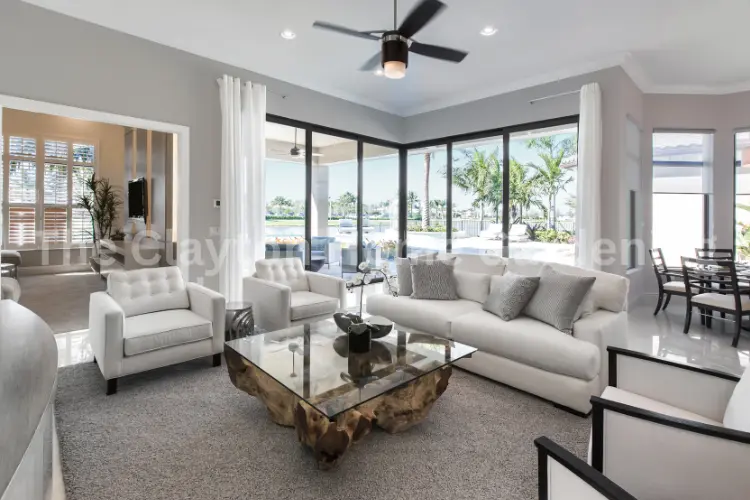
In general, Tudor homes share several common features. They feature steeply pitched roofs that has multiple, front-facing gables. They typically feature a façade that is primarily constructed of brick, however they are also adorned by half-timber frames (widely spaced wooden boards that have stucco or stone between). Each house has prominently placed stone or brick chimneys that can be decorated with designs. The casement windows are higher than those you see on other homes, and have diamond-shaped or rectangular panes that represent the Medieval-style. Windows can also be put together. The front doors usually look like castles and. Because of the popularity of symmetrical design in Tudors the doors are usually off-center and have a round arch on top of the doorway or door typically made of stone, which contrasts with the brick.
Tudor-style homes are extremely traditional. Moreover, since the design was developed in warmer regions, it’s not common to come across one with an exterior porch that enhances the formal appearance of the curb. These charming homes are perfectly set in beautiful greenery and flowers (English gardens are well-known for their flowers) which add a warm appearance on the outside.
Innovative Tudor Style House Designs for Modern Living
While traditional Tudor homes are constructed with costly materials like genuine wood and stone, contemporary Tudor houses are more budget-friendly and low-maintenance alternatives. Common materials in modern Tudor designs are:
Brick, cultured stone or stucco facades – Machine-cut stone as well as faux stone gives the look of hand-laid masonry, but at a lower cost. Stucco is a different, cost-effective façade material.
Fiber cement or vinyl siding – for half-timbering and upper gables Vinyl panels or fiber cement boards look like wood trim, but without the maintenance.
Asphalt shingles are now more durable and weather-proof asphalt roofing shingles come with layered designs that resemble wood shakes.
Steel beams – The latest steel structural elements can be used to create larger spans within without the weight of wood timbers.
Engineered wood floors – durable and sustainable, engineered hardwood planks give the appearance of wood but are much less expensive. Energy efficient windows such as Vinyl, up or wooden frames that have insulation provide a classic look and modern energy efficiency. Accents made of faux wrought iron – Lightweight composite metalwork mimics the appearance of hand-forged iron railings, stairs and lighting. Once a cult style, Tudor-style homes are not as prevalent in modern construction as farmhouse and colonial styles dominating suburban communities. But the Tudor remains an important historical architectural influence. By blending traditional Tudor elements with modern-day materials, the contemporary Tudor style is able to carry this distinctive style forward, allowing for the inspiration of younger generations of homeowners. Although they aren’t common, the homes of these houses are a bridge to the past and meet modern needs if they are designed with care.
Windows Used in Modern Tudor Homes
Windows are the most distinctive characteristic of Tudor-style houses. If you’re wondering what exactly a Tudor home is, it is an historic architectural style that is distinguished by its soaring gabled roofs, attractive half-timbering and unique windows. While remaining in the tradition of the original style contemporary Tudor windows are expanded and modernized to meet the demands of today’s.
Common windows in Tudor styles of house design are:
Casement windows
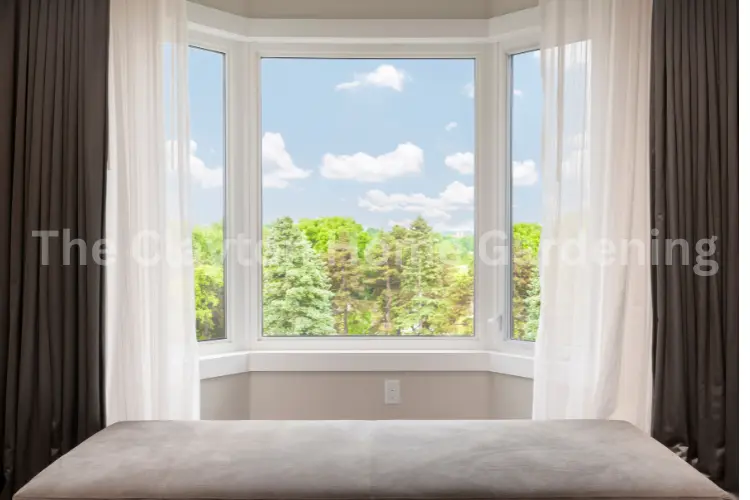
They are usually arranged in large, dramatic expanses.
Arched transom windows
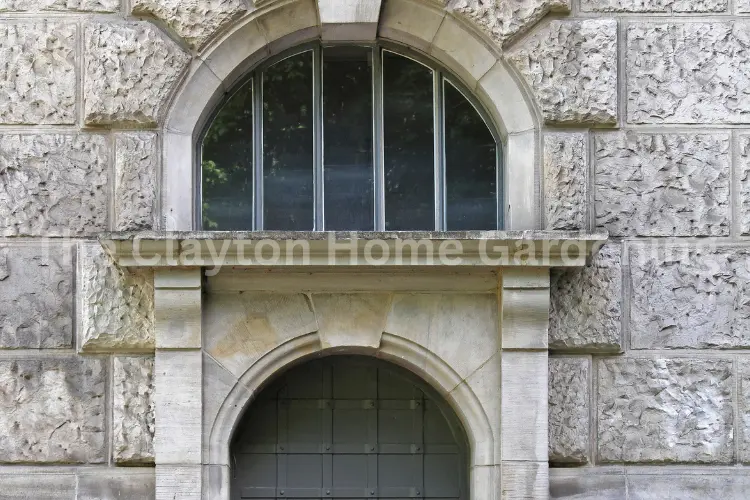
Placed over entryways.
Bay windows
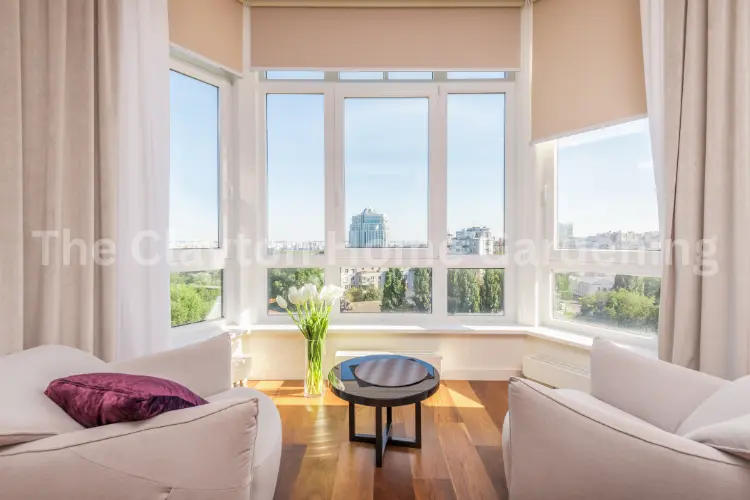
extending from the first or second story.
Double-hung windows
featuring grids of rectangular shapes.
Oriel windows
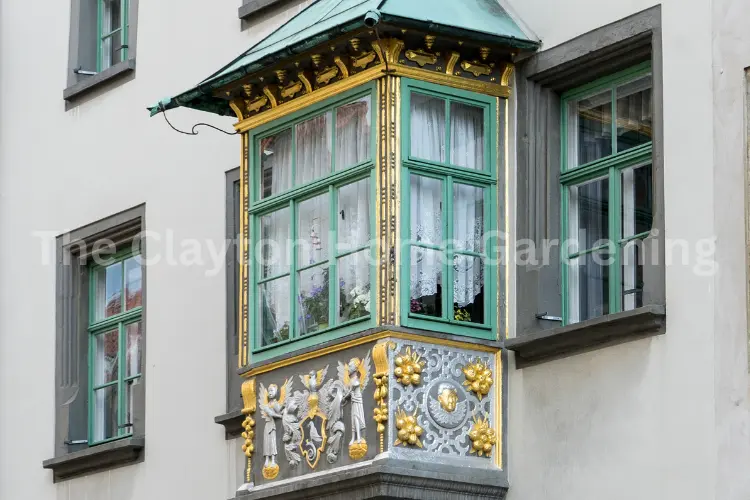
protruding from the facades on the upper levels.
Dormer windows

Combining signature Tudor windows such as these with large scales and modern materials, the contemporary Tudor style bathes interiors with natural light, while also preserving the appeal of traditional architectural. Knowing what constitutes an Tudor building and the incorporation of these features into Tudor styles of house design can allow homeowners to appreciate a combination of classic elegance and modern-day practicality.
The Allure of Modern Tudor Style: Elegance Redefined
Front doors are the central feature in any Tudor home that sets the stage for the classic Medieval style and elegance. Here are some typical front door characteristics you will find in Modern Tudors:
- Doors of solid wood that feature decorative design panels or planked designs
- Arches in doors, usually with archtops that are flattened or rounded.
- Elegantly carved wood surrounds and trimming
- Iron hinges made of wrought iron as well as handles, knockers and handle
- Glass inserts or sidelights to provide extra illumination
- Colors that are striking and striking, such as blue, green, red or black
- Overhead arches adorned with stonework
The intricate wood details evoke the spirit of the historic Tudors Modern materials such as steel and fiberglass provide long-lasting and low-maintenance alternatives. However, the grand dimensions and striking profiles are still and communicate Medieval elegance. Knowing Tudor house features of the Tudor style is vital to fully appreciate these architectural aspects.
Today’s Tudor doors greet guests with timeless style as they stand up to daily use. Their stunning appearance creates an unforgettable impression on guests and enhances the Tudor style home’s interior.
Modern Tudor-style homes are found throughout the United States, blending the tradition of the Tudor architectural style with modern materials and modern amenities. Here are a few areas in which you can locate amazing examples of these in the real world:
- New Jersey: Many modern Tudor homes are situated in suburban areas, such as Montclair, Summit, and Westfield.
- New York: Neighborhoods in Long Island, Westchester County and parts of Queens are modernized versions that are reminiscent of Tudor style.
- Pennsylvania Suburbs of Philadelphia such as Bryn Mawr, Villanova, and Wayne have homes that are modern in Tudor style.
These contemporary Tudor houses blend historical character with modern, open designs that can be adapted to 21st century living styles, showing how the Tudor style is a cherished design option. By taking these Tudor features into the house, and adding a touch of elegance to the Tudor style of interiors it is possible to create a space that displays the timeless elegance and modern comfort.
Tudor House Characteristics: The Architectural Features that define an era
Tudor homes are distinguished by their Gable roofs, intricately designed chimneys made of masonry (often filled with chimney pots) and embellished doors as well as groups of windows, and decorative half-timbering. This is a visible timber frame, with the spaces between the timbers being filled with stucco or masonry.
Materials
There are a variety of easily recognizable aspects that are characteristic of American Tudor architecture. The most obvious is stucco walls that are with no decorative wood half-timbering. Some Tudor homes of this type were built with weatherboard or shingled walls that had stucco and half-timbered gables. Another Tudor style homes made use of stone for walls, usually with the addition of a decorative stone trim. The most common construction material used in American Tudor homes was brick which was often laid out in a complex pattern in the first story, and complemented by an additional story made of wood or stucco and fake half-timbering laid out with a pattern of decorative design.
Roof
One distinctive feature in Tudor architectural and aesthetics was its steep roof that was often adorned by small dormers and covered with slate. The main gable often included a second side which was called a cross gable. Gable ends were usually covered with verge boards, whose decorations varied from basic to elaborately detailed. Some gables were fitted with parapets. This is extremely English.
Windows
Tudor style houses typically featured casement windows that were arranged by rows of 3 or more and framed with metal or wood. Double-hung windows were not as common. Windows were typically divided into 6 or 8 panes. They were often rectangles, and sometimes they were arranged in a diamond pattern. Windows were typically placed in a symmetrical manner within the gable’s main area.
Entrance
The Tudor front door to a home was a part of an asymmetrical arrangement with architectural components, some of which were decorative and others designed to offer protection. Security was provided by a strong brick wall, which let the door be recessed, or a protruding bay window, or a tiny roof above the door. Renaissance decorations comprised arched entrances batten and board doors with a luxurious black metal door hardware, and tabs made of stone cut into the brick wall creating a look similar to a quoin.
The characteristics of a Tudor home are the combination of historical elegance and modern-day functionality. Knowing these Tudor features of a home aids in understanding the intricate particulars that make these homes distinctive.
Tudor-Style Homes with charming English-inspired architecture
It is distinguished by their steeply sloping rooflines, and decorative half-timbering a Tudor-style home could range from a grand mansion or a simple suburban home. These lovely structures are typically modeled after the classic English design, with solid materials and beautiful details. These Tudor houses bring that traditional design into modern times.
Modern Tudor Style
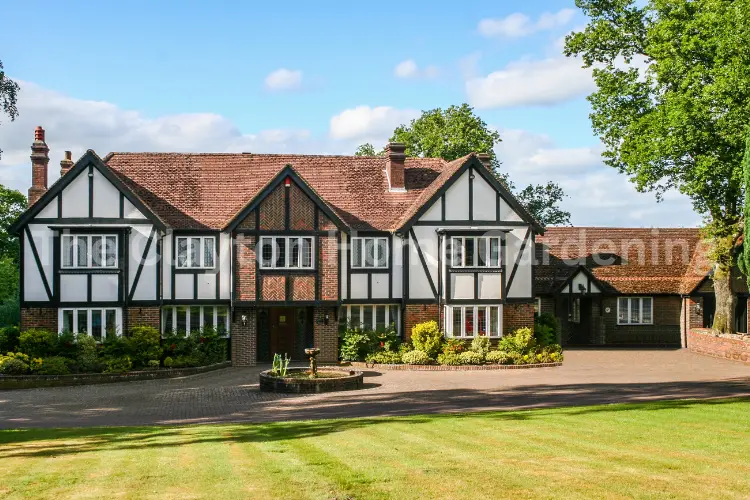
Tudor-style houses are typically decorated with half-timbering. This is the term used to describe the wood frame, which is then covered with stone or stucco. The updated Tudor-style house offers a contemporary take on this classic design with a chic black paint. The deep, dark color is also a great accent for the exterior trim as well as the front door, bringing distinction to the white-painted brick and exposed red brick.
Hallmarks of Tudor Style
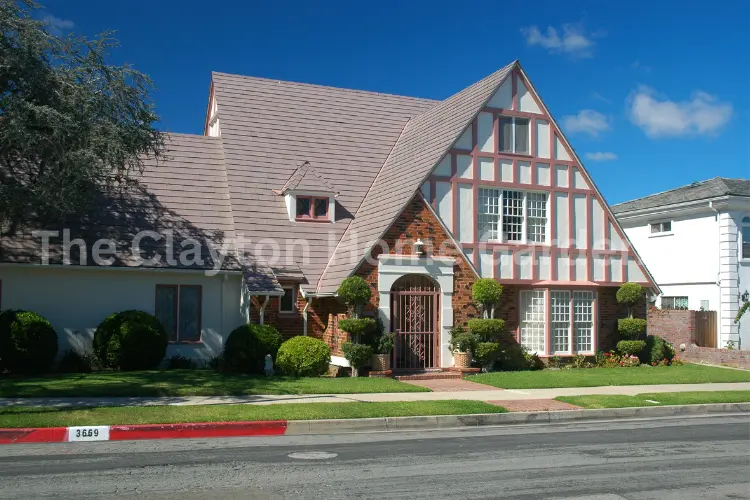
In contrast to Colonials with their slender geometric shapes houses in the Tudor style can be built in many different types and designs. The exteriors are typically Asymmetrical with energetic rooflines with mixed materials for facades. Gables and windows of various dimensions, off-center front doors as well as numerous chimneys are typical of the design. The wide stone stairwell that leads towards the doorway is a sign of splendor, and emphasizes the formality in Tudor architecture.
Tudor-Style Renovation
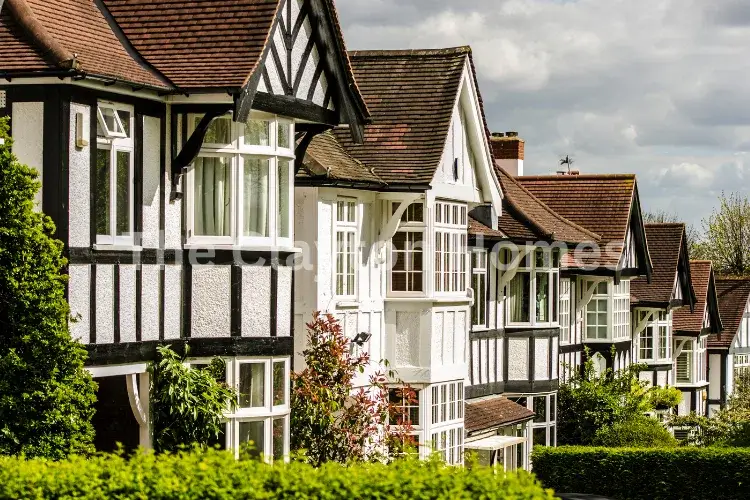
While the design has historic origins, modernizations can help a Tudor-style residence appear modern for the 21st century. In this case, an arched overhang that is atop an entrance door, narrow windows, and the overlapping gables continue to use traditional Tudor architectural details. The sleek grey and white siding give the exterior modern, fresh style. The front door is made of wood and has an elongated window that is reminiscent of the arches and provides an unintentionally modern look too. Simple landscaping permits the house to remain the center feature for the entire property.
Traditional Tudor Materials
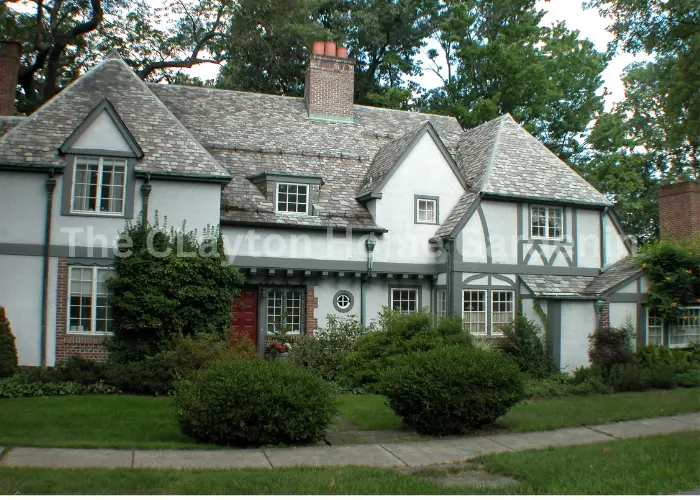
The homes of the Tudor style are usually set off by areas of stucco, stone or even wood in the gables or on upper stories. The front of this house’s gable dormer is half-timbered with stucco infill. Cypress shakes add some texture, and also provide contrast with the outside siding while the wooden shutters and front door add a touch of style.
Tudor Color Schemes
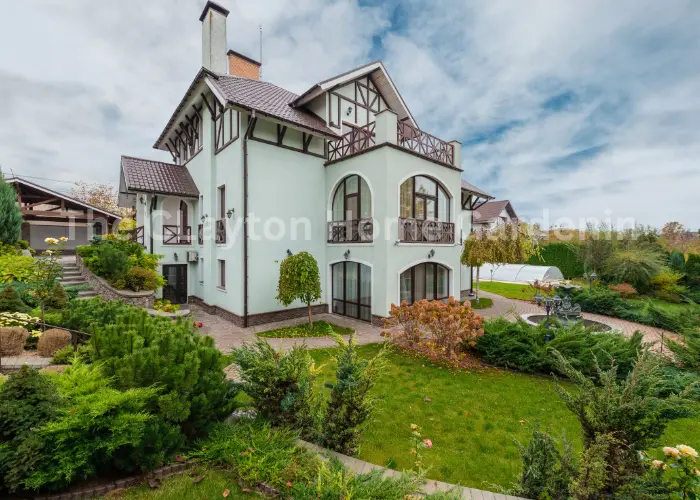
Cream brown, white, and cream tones are often used as the exterior palettes of Tudor-style homes. These neutral colors go well with traditional brick, stone slate, and concrete. The front doors are usually painted to emphasize the natural wood grain. They also can be painted to add an accent color for an unusual surprise. The lush greenery growing upwards and around the entryway enhances the natural beauty of the house.
Arched Tudor-Style Doorway
An arched-style doorway, such as this, is a typical element of a Tudor-style home. The exterior of this house is adorned with a variety of distinctive Tudor materials, like stones on the front of the gable and half-timbering that has stucco infill on the upper part of the. The front steps stones of different sizes are laid out in a dazzling pattern, adding a modern accent.
Tudor Revival

The home’s traditional style is a part of Tudor but also English country. Particularly distinctive features are the Gothic limestone arch over the entrance as well as copper gutters and board-and-batten siding. The trim in cream highlights windows and other features on the exterior with the contrast of red brick. Low hedges cut with curved forms are a more casual feature for landscaping that emphasize the country aspect of the design.
Renaissance Details
The entryway to homes built in the Tudor style will typically have Renaissance detail. Additionally, Tudor arches (typically with flat and sharp tops) are typically seen in door surrounds, like the one shown here. The limestone door surround enhances the castle-like look of the house and gives a more prominent appearance to the front entrance.
Tudor Curb Appeal
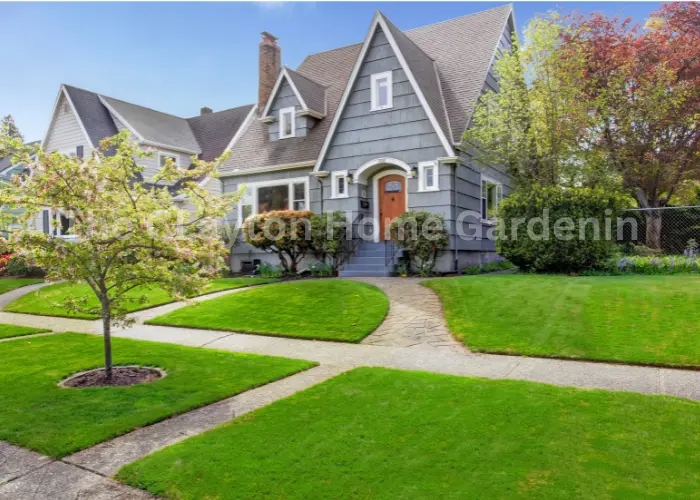
A red-brick curved walkway is a reflection of the home’s exterior cladding. Meanwhile, an abundance of greenery provides an atmosphere of a book that enhances the welcoming entrance. The pathway winds through an arbor covered in flowers and then leads to an arch entryway. Brickwork with patterns and half-timbering in black adds visual attraction to the facade of the home.
Tudor Half-Timbering
Usually found on Tudor-style homes half-timbering with ornamental designs mimic the medieval techniques of construction. Timber framing was an integral part to the construction of medieval homes, the majority of examples found on contemporary Tudor houses are simply decorative. There are a variety of designs and patterns that are available, however the method is usually used for the upper floors and around windows.
Leaded-Glass Windows
Large narrow windows, typically in multi-pane glazing, are typical of Tudor-style homes. Leaded glass windows that are small and have geometric designs are another popular characteristic of the past. This diamond-pattern leaded glass window that is capped with antique timber gives the home an aged look.
Brick Tudor

The exterior of a Tudor-style residence is often highlighted by one or more striking high-pitched cross gables. The home has two gables in the front and walls clad in brick. Brick became the wall covering for even the tiniest Tudor cottages following the popularity of masonry veneering in the 1920s. The arches around the portico that leads towards the entrance are echoed over the large front window as well as in the window that is smaller above the entranceway. Arches are frequently found in Tudor architectural styles.
Updated Brick Tudor

A different exterior color scheme provided this Tudor-style brick house with an updated look. Different hues of green such as grey-green shutters and sage-painted brick bring a fresh look to the traditional facade, without altering its design. Copper gutters show the weathered patina of their work and provide an authentic look, while windows in the upper portion of the house adds an element of romance.
Stone Tudor
While stone trim is not a common feature in Tudor-style homes This home uses stone as the main wall for cladding. In this type stucco, brick or wood trim is often used to cover gables or the second story. The wall is also constructed of stone as a part of the house. The warm blue of the shutters creates an air of softness to the stone’s cool exterior.
Manufactured Stone Facade
The stone that is manufactured in this house’s exterior aids in enhancing the Tudor appearance. Although it is akin to natural stone, artificial versions typically are less expensive than the price. To keep with the design red brick trims the steep roofline, as well as arched windows and doors. Brick is also atop the wall of the gated entryway to the house as well as being covered by manufactured stones.
Tudor-Style Cottage
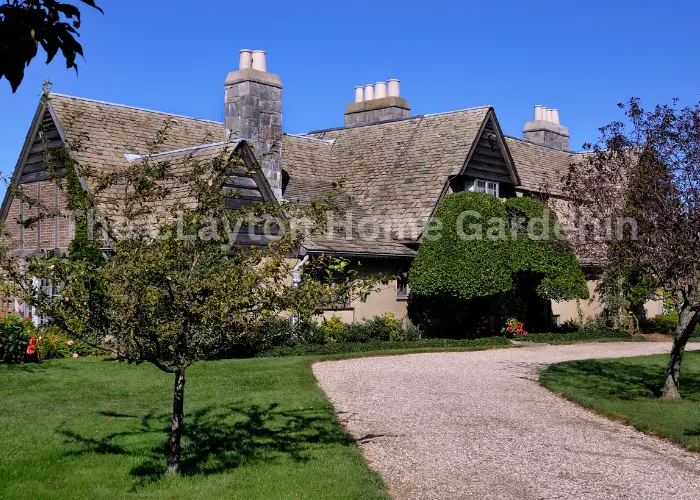
Tulips weave their way through the front of this lovely Tudor-style cottage. A hand-crafted wreath that is placed on the front door echoes the design of the arched doors and adjacent windows. The floral arrangement features silk flowers that match the tulip displays’ color scheme and also reflect the color of the bricks that cover the exterior.
Lakeside Tudor
Beautiful architecture typically takes in the surroundings, but in this Tudor-style house this is not the case. The grand home is embraced by the surrounding landscape, which includes beautiful lake shores that wrap around the property across three different sides. A slate-tile roof as well as chimneys offset from the house’s exterior, and are shaded by a huge tree that grows on the edge of an outdoor seating space.
Modern-Day Tudor

This brand-new English Tudor-style house was conceived to appear older. The inspiration came from the classical architectural style of a close-by estate and school. A well-balanced layout that includes an exterior with stone-clad as well as brick chimneys and the chocolate-brown trim offers classic Tudor aesthetic. Arches are repeated on the exterior of the downstairs and the split glass unite all windows, despite their various dimensions and shapes, further enhancing the harmony of the home.
English Character
Stone, brick stucco, wood, and brick add to the Tudor-style. The mix of materials brings various natural patterns and colors to the exterior. The half-timbering design is decorative and features curves and diagonals to give a unique twist to traditional. The home’s multi-faceted exterior are climbing vines often found on older houses as well as carefully cut hedges along the driveway as well as surrounding the front entryway.
Medieval Revival
Massive chimneys and high pitched roofs lend Tudor style buildings the appearance of a medieval. The style is sometimes referred to as Medieval Revival. The windows of this home are filled with casements, a further characteristic of this style. The grand gate that is located in the entryway enhances the vintage feel, and painted shutters are a beautiful design that is a perfect match with the roof.
Exposed Wood Details
The wooden beams that are exposed as well as the front doors made of wood on this Tudor-style house lend it the French country-style look which inspired the woodland decor scheme. The tree’s branches as well as greenery from the forest keep the design simple with silvery stars, and Tin tree luminaries give an element of Christmas decor. Glass panes with diamond shapes give the door a vintage appearance.
Tudor-Style Windows
The windows in Tudor-style homes are usually grouped into strings that are three to more. They’re usually located above or beneath the main gable. They are also found in two-story or one-story semi hexagonal bays such as those above the front doorway. Small transoms are sometimes placed above the main windows, like those in the main area of this house.
Tudor-Style Solarium
The windows in this solarium re-create Gothic Arches as well as diamond-shaped panes which are found throughout the Tudor-style home. The solarium is open to a patio with a dining set to host outdoor gatherings. A breezeway that connects it to the main house makes for an informal breakfast space. A distinct shade of brown, it marks it as a distinct space even though it is connected to the house. The solarium serves as an interconnection between the inside and out.
